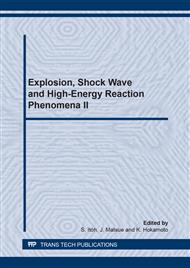[1]
S. Saravanan and K. Raghukandan, Weldability Windows for Explosive Cladding of Dissimilar Metals, Advanced Materials Research, 445 (2012) 729-734.
DOI: 10.4028/www.scientific.net/amr.445.729
Google Scholar
[2]
S. Saravanan and K. Raghukandan, Energy Dissipation in Explosive Welding of Dissimilar Metals, Materials Science Forum. 673 (2011) 125-129.
DOI: 10.4028/www.scientific.net/msf.673.125
Google Scholar
[3]
Nizamettin Kahraman, Behcet Gulenc and Fehim Findik, Joining of titanium/stainless steel by explosive welding and effect on interface, J. Mater. Proces. Tech. 169 (2005) 127–133.
DOI: 10.1016/j.jmatprotec.2005.06.045
Google Scholar
[4]
Bogumil Wronka, Testing of explosive welding and welded joints. Wavy character of the process and joint quality. Int. J. Imp. Engg. 38(5) (2011) 309-313.
DOI: 10.1016/j.ijimpeng.2010.11.003
Google Scholar
[5]
F.A. Baum, L.P. Orlenko and K.P. Stanyukovich, Physics of explosion, Nauka, Moscow (1975).
Google Scholar
[6]
K. Hokamoto, A. Chiba, M. Fujita and T. Izuma, Single-shot explosive welding technique for the fabrication of multilayered metal base composites: effect of welding parameters leading to optimum bonding condition. Composites engineering, 5 (1995).
DOI: 10.1016/0961-9526(95)00059-v
Google Scholar
[7]
P. Manikandan, K. Hokamoto, M. Fujita, K. Raghukandan, R. Tomoshige: Control of energetic conditions by employing interlayer of different thickness for explosive welding of titanium/304 stainless steel. J. Mater. Proces. Tech. 195 (2008) 232–240.
DOI: 10.1016/j.jmatprotec.2007.05.002
Google Scholar
[8]
S. Saravanan and K. Raghukandan, Influence of interlayer in explosive cladding of dissimilar metals" Materials and Manufacturing Processes In press (2013).
DOI: 10.1080/10426914.2012.736665
Google Scholar
[9]
DOI: 10. 1080/10426914. 2012. 736665.
Google Scholar
[10]
S. Saravanan and K. Raghukandan, Thermal kinetics in explosive cladding of dissimilar metals, Sci. Tech. Weld. Joi. 17 (2) (2012) 99-103.
DOI: 10.1179/1362171811y.0000000080
Google Scholar
[11]
A.R. Miedema, R. Boom and F. R De Boer, on the heat of Formation of Solid alloys. J. Less Common Metals, 41(2) (1975) 283-298.
DOI: 10.1016/0022-5088(75)90034-x
Google Scholar


